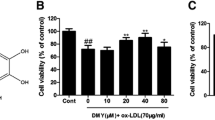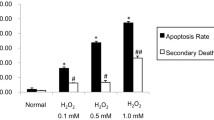Abstract
This study was conducted to investigate the damage caused by vanadium compounds and to explore the protective effects of berberine (BBR) in human umbilical vein endothelial cells (HUVECs). BBR is a biologically active small molecule found in Coptis rhizome, a remedy used in traditional Chinese medicine to treat diabetes. BBR has also been shown to lower blood glucose in diabetic patients. MTT assay was performed to observe the influence of bis(acetylacetonato)-oxidovanadium [VO(acac)2] or sodium metavanadate (NaVO3) and BBR on viability of HUVECs. The monolayer permeability of the HUVECs was assessed by measuring the transendothelial electrical resistance (TER). The endothelial nitric oxide synthase (eNOS) activity was detected by ELISA. Flow cytometry was performed to detect the generation of reactive oxygen species (ROS). The results showed that the viability of HUVECs was decreased by treatment with vanadium compounds 50–400 μM in a concentration-dependent manner, while 0.01–1 μM BBR effectively protected HUVECs from the inhibitory effects of vanadium compounds on cell viability. Also 100 and 200 μM VO(acac)2 induced high permeability and decreased eNOS activity in HUVECs. While 0.01–1 μM BBR showed no improvement in the permeability, and failed to reverse the VO(acac)2-induced changes of eNOS activity, but BBR treatment increased the eNOS activity in control cells. The addition of 200 μM VO(acac)2 significantly induced ROS generation in HUVECs, while 0.01 or 0.1 μM BBR reversed the change of ROS. In summary, BBR has protective effects in HUVECs damage induced by vanadium compounds, which is not mediated by eNOS, but related to reduced intracellular ROS.





Similar content being viewed by others
Abbreviations
- VO(acac)2 :
-
Bis(acetylacetonato)-oxidovanadium(IV)
- NaVO3 :
-
Sodium metavanadate(V)
- BBR:
-
Berberine
- HUVECs:
-
Human umbilical vein endothelial cells
- MTT:
-
3-(4, 5-Dimethylthiazoyl-2-yl) 2, 5-diphenyltetrazolium bromide
- eNOS:
-
Endothelial nitric oxide synthase
- iNOS:
-
Inducible nitric oxide synthase
- tNOS:
-
Total nitric oxide synthase
- NO:
-
Nitric oxide
- TER:
-
Transendothelial electrical resistance
- ROS:
-
Reactive oxygen species
- DMEM:
-
Dulbecco’s modified eagle medium
- FBS:
-
Fetal bovine serum
- DCFH-DA:
-
2′-7′-Dichlorofluorescein-diacetate
- DMSO:
-
Dimethylsulfoxide
References
Batori R, Becsi B, Nagy D, Konya Z, Hegedus C, Bordan Z et al (2017) Interplay of myosin phosphatase and protein phosphatase-2A in the regulation of endothelial nitricoxide synthase phosphorylation and nitric oxide production. Sci Rep 7:44698. https://doi.org/10.1038/Srep44698
Bharathi BV, Prakash GJ, Krishna KM, Krishna CHR, Sivanarayana T, Madan K et al (2015) Protective effect of alpha glucosyl hesperidin (G-hesperidin) on chronic vanadium induced testicular toxicity and sperm nuclear DNA damage in male Sprague Dawley rats. Andrologia 47(5):568–578. https://doi.org/10.1111/and.12304
Cheng F, Wang Y, Li J, Su C, Wu F, Xia WH et al (2013) Berberine improves endothelial function by reducing endothelial microparticles-mediated oxidative stress in humans. Int J Cardiol 167(3):936–942. https://doi.org/10.1016/j.ijcard.2012.03.090
Cho YE, Basu A, Dai AZ, Heldak M, Makino A (2013) Coronary endothelial dysfunction and mitochondrial reactive oxygen species in type 2 diabetic mice. Am J Physiol Cell Physiol 305(10):C1033–C1040. https://doi.org/10.1152/ajpcell.00234.2013
Chun F, Zhang BB, Lin H, Gao CF, Min W (2018) d-fagomine attenuates high glucose-induced endothelial cell oxidative damage by upregulating the expression of PGC-1alpha. J Agric Food Chem 66(11):2758–2764. https://doi.org/10.1021/acs.jafc.7b05942
Clark TA, Maddaford TG, Tappia PS, Heyliger CE, Ganguly PK, Pierce GN (2010) Restoration of cardiomyocyte function in streptozotocin-induced diabetic rats after treatment with vanadate in a tea decoction. Curr Pharm Biotechnol 11(8):906–910
Coderre L, Srivastava AK (2004) Vanadium and the cardiovascular functions. Can J Physiol Pharmacol 82(10):833–839. https://doi.org/10.1139/y04-089
Cui W, Guo HR, Cui HM (2015) Vanadium toxicity in the thymic development. Oncotarget 6(30):28661–28677. https://doi.org/10.18632/oncotarget.5798
Forstermann U, Munzel T (2006) Endothelial nitric oxide synthase in vascular disease—from marvel to menace. Circulation 113(13):1708–1714. https://doi.org/10.1161/Circulationaha.105.602532
Forstermann U, Sessa WC (2012) Nitric oxide synthases: regulation and function. Eur Heart J 33(7):829. https://doi.org/10.1093/eurheartj/ehr304
Fukunaga K (2012) Benefit of vanadium compound in therapy for cardiovascular diseases. Yakugaku Zasshi 132(3):279–284
Geng FH, Li GH, Zhang X, Zhang P, Dong MQ, Zhao ZJ et al (2016) Berberine improves mesenteric artery insulin sensitivity through up-regulating insulin receptor-mediated signalling in diabetic rats. Br J Pharmacol 173(10):1569–1579. https://doi.org/10.1111/bph.13466
Ghosh SK, Saha R, Saha B (2015) Toxicity of inorganic vanadium compounds. Res Chem Intermed 41(7):4873–4897. https://doi.org/10.1007/s11164-014-1573-1
Gong X, Ma Y, Ruan YJ, Fu GH, Wu SZ (2014) Long-term atorvastatin improves age-related endothelial dysfunction by ameliorating oxidative stress and normalizing eNOS/iNOS imbalance in rat aorta. Exp Gerontol 52:9–17. https://doi.org/10.1016/j.exger.2014.01.015
Gruzewska K, Michno A, Pawelczyk T, Bielarczyk H (2014) Essentiality and toxicity of vanadium supplements in health and pathology. J Physiol Pharmacol 65(5):603–611
Hadi HA, Suwaidi JA (2007) Endothelial dysfunction in diabetes mellitus. Vasc Health Risk Manag 3(6):853–876
Hosseini MJ, Shaki F, Ghazi-Khansari M, Pourahmad J (2013) Toxicity of vanadium on isolated rat liver mitochondria: a new mechanistic approach. Metallomics 5(2):152–166. https://doi.org/10.1039/c2mt20198d
Hosseini MJ, Shahraki J, Tafreshian S, Salimi A, Kamalinejad M, Pourahmad J (2016) Protective effects of Sesamum indicum extract against oxidative stress induced by vanadium on isolated rat hepatocytes. Environ Toxicol 31(8):979–985. https://doi.org/10.1002/tox.22107
Huang PL (2003) Endothelial nitric oxide synthase and endothelial dysfunction. Curr Hypertens Rep 5(6):473–480
Irving E, Stoker AW (2017) Vanadium compounds as PTP inhibitors. Molecules 22(12):2269. https://doi.org/10.3390/Molecules22122269
Jakusch T, Kiss T (2017) In vitro study of the antidiabetic behavior of vanadium compounds. Coordin Chem Rev 351:118–126. https://doi.org/10.1016/j.ccr.2017.04.007
Jhang KA, Park JS, Kim HS, Chong YH (2017) Resveratrol ameliorates tau hyperphosphorylation at Ser396 site and oxidative damage in rat hippocampal slices exposed to vanadate: implication of ERK1/2 and GSK-3/beta signaling cascades. J Agric Food Chem 65(44):9626–9634. https://doi.org/10.1021/acs.jafc.7b03252
Leon IE, Cadavid-Vargas JF, Di Virgilio AL, Etcheverry SB (2017) Vanadium, ruthenium and copper compounds: a new class of nonplatinum metallodrugs with anticancer activity. Curr Med Chem 24(2):112–148. https://doi.org/10.2174/0929867323666160824162546
Li Z, Carter JD, Dailey LA, Huang Y-CT (2004) Vanadyl sulfate inhibits NO production via threonine phosphorylation of eNOS. Environ Health Perspect 112(2):201–206
Li H, Zhou DL, Zhang Q, He KP, Feng CY, Lan YJ (2013) Cardiovascular system symptoms and blood pressure in workers exposed to vanadium. J Environ Occup Med 02:140–142
Li JN, Zhang Z, Xing WJ, Geng FH, Dong L, Gao F (2014) Berberine improves coronary vasodilation and prevents endothelial apoptosis via activating Akt-eNOS in diabetic rats. J Am Coll Cardiol 64(16):C3–C3
Liao YF, Gou LN, Chen LL, Zhong XY, Zhang DX, Zhu HG et al (2018) NADPH oxidase 4 and endothelial nitric oxide synthase contribute to endothelial dysfunction mediated by histone methylations in metabolic memory. Free Radic Bio Med 115:383–394. https://doi.org/10.1016/j.freeradbiomed.2017.12.017
Liu TT, Liu YJ, Wang Q, Yang XG, Wang K (2012) Reactive-oxygen-species-mediated Cdc25C degradation results in differential antiproliferative activities of vanadate, tungstate, and molybdate in the PC-3 human prostate cancer cell line. J Biol Inorg Chem 17(2):311–320. https://doi.org/10.1007/s00775-011-0852-1
Liu JC, Yu Y, Wang G, Wang K, Yang XG (2013) Bis(acetylacetonato)-oxovanadium(IV), bis(maltolato)-oxovanadium(IV) and sodium metavanadate induce antilipolytic effects by regulating hormone-sensitive lipase and perilipin via activation of Akt. Metallomics 5(7):813–820. https://doi.org/10.1039/c3mt00001j
Niu X, Xiao R, Wang N, Wang Z, Zhang Y, Xia Q et al (2016) The molecular mechanisms and rational design of anti-diabetic vanadium compounds. Curr Top Med Chem 16(8):811–822
Pessoa JC, Etcheverry S, Gambino D (2015) Vanadium compounds in medicine. Coordin Chem Rev 301:24–48. https://doi.org/10.1016/j.ccr.2014.12.002
Pirillo A, Catapano AL (2015) Berberine, a plant alkaloid with lipid- and glucose-lowering properties: from in vitro evidence to clinical studies. Atherosclerosis 243(2):449–461. https://doi.org/10.1016/j.atherosclerosis.2015.09.032
Roy S, Majumdar S, Singh AK, Ghosh B, Ghosh N, Manna S et al (2015) Synthesis, characterization, antioxidant status, and toxicity study of vanadium-rutin complex in Balb/c mice. Biol Trace Elem Res 166(2):183–200. https://doi.org/10.1007/s12011-015-0270-2
Shechter Y, Shisheva A (1993) Vanadium salts and the future treatment of diabetes. Endeavour 17(1):27–31
Shirwaikar A, Shirwaikar A, Rajendran K, Punitha ISR (2006) In vitro antioxidant studies on the benzyl tetra isoquinoline alkaloid berberine. Biol Pharm Bull 29(9):1906–1910. https://doi.org/10.1248/Bpb.29.1906
Shukla R, Bhonde RR (2008) Adipogenic action of vanadium: a new dimension in treating diabetes. Biometals 21(2):205–210. https://doi.org/10.1007/s10534-007-9109-4
Soussi A, Abdennabi R, Ghorbel F, Murat JC, El Feki AF (2017) Ameliorated effects of (-)-epigallocatechin gallate against toxicity induced by vanadium in the kidneys of wistar rats. Biol Trace Elem Res 180(2):239–245. https://doi.org/10.1007/s12011-017-1004-4
Soveid M, Dehghani GA, Omrani GR (2013) Long- term efficacy and safety of vanadium in the treatment of type 1 diabetes. Arch Iran Med 16(7):408–411
Tesfamariam B, DeFelice AF (2007) Endothelial injury in the initiation and progression of vascular disorders. Vasc Pharmacol 46(4):229–237. https://doi.org/10.1016/j.vph.2006.11.005
Thompson KH, Orvig C (2006) Vanadium in diabetes: 100 years from phase 0 to phase I. J Inorg Biochem 100(12):1925–1935. https://doi.org/10.1016/j.jinorgbio.2006.08.016
Thompson KH, Lichter J, Lebel C, Scaife MC, McNeill JH, Orvig C (2009) Vanadium treatment of type 2 diabetes: a view to the future. J Inorg Biochem 103(4):554–558. https://doi.org/10.1016/j.jinorgbio.2008.12.003
Trevino S, Velazquez-Vazquez D, Sanchez-Lara E, Diaz-Fonseca A, Flores-Hernandez JA, Perez-Benitez A et al (2016) Metforminium decavanadate as a potential metallopharmaceutical drug for the treatment of diabetes mellitus. Oxid Med Cell Longev. https://doi.org/10.1155/2016/6058705
Van Dam PS, Cotter MA, Bravenboer B, Cameron NE (2013) Pathogenesis of diabetic neuropathy: focus on neurovascular mechanisms. Eur J Pharmacol 719(3):180–186. https://doi.org/10.1016/j.ejphar.2013.07.017
Velescu BS, Anuta V, Aldea A, Jinga M, Cobeleschi PC, Zbarcea CE et al (2017) Evaluation of protective effects of quercetin and vanadyl sulphate in alloxan induced diabetes model. Farmacia 65(2):200–206
Wang YQ, Huang Y, Lam KSL, Li YM, Wong WT, Ye HY et al (2009) Berberine prevents hyperglycemia-induced endothelial injury and enhances vasodilatation via adenosine monophosphate-activated protein kinase and endothelial nitric oxide synthase. Cardiovasc Res 82(3):484–492. https://doi.org/10.1093/cvr/cvp078
Wang QL, Zhang M, Liang B, Shirwany N, Zhu Y, Zou MH (2011) Activation of AMP-activated protein kinase is required for berberine-induced reduction of atherosclerosis in mice: the role of uncoupling protein2. PLoS ONE 6(9):e25436. https://doi.org/10.1371/journal.pone.0025436
Wang N, Wang ZW, Niu X, Yang XD (2015) Synthesis, characterization and anti-diabetic therapeutic potential of novel aminophenol-derivatized nitrilotriacetic acid vanadyl complexes. J Inorg Biochem 152:104–113. https://doi.org/10.1016/j.jinorgbio.2015.07.012
Wu JX, Hong YH, Yang XG (2016) Bis(acetylacetonato)-oxidovanadium(IV) and sodium metavanadate inhibit cell proliferation via ROS-induced sustained MAPK/ERK activation but with elevated AKT activity in human pancreatic cancer AsPC-1 cells. J Biol Inorg Chem 21(8):919–929. https://doi.org/10.1007/s00775-016-1389-0
Yang XG, Yang XD, Yuan L, Wang K, Crans DC (2004) The permeability and cytotoxicity of insulin-mimetic vanadium compounds. Pharm Res 21(6):1026–1033
Yao J, Kong WJ, Jiang JD (2015) Learning from berberine: treating chronic diseases through multiple targets. Sci China Life Sci 58(9):854–859. https://doi.org/10.1007/s11427-013-4568-z
Yerra VG, Kalvala AK, Sherkhane B, Areti A, Kumar A (2018) Adenosine monophosphate-activated protein kinase modulation by berberine attenuates mitochondrial deficits and redox imbalance in experimental diabetic neuropathy. Neuropharmacology 131:256–270. https://doi.org/10.1016/j.neuropharm.2017.12.029
Zhan XL, Liu S, Zhi MH, Li C, Liang HY, Tong MM et al (2017) Effects of berberine on morphological changes of mesenteric vessels in diabetic rats. Chin J Micro 1(27):6–10
Zhang ZF, Chen J, Han X, Zhang Y, Liao HB, Lei RX et al (2017) Bisperoxovandium (pyridin-2-squaramide) targets both PTEN and ERK1/2 to confer neuroprotection. Br J Pharmacol 174(8):641–656. https://doi.org/10.1111/bph.z3727
Acknowledgements
This study is financially supported by the Grants from The Science and Technology Support programs of Hebei Province No. 17967753D, National Nature Science Foundation of China No. 31800975, The Medical Science research project of Hebei Province No. 20190034 and The Science and Technology research project of Hebei higher education institutions No. QN2017104.
Author information
Authors and Affiliations
Corresponding author
Additional information
Publisher's Note
Springer Nature remains neutral with regard to jurisdictional claims in published maps and institutional affiliations.
Rights and permissions
About this article
Cite this article
Hou, CC., Liang, HY., Pan, YH. et al. Vanadium compounds induced damage of human umbilical vein endothelial cells and the protective effect of berberine. Biometals 32, 785–794 (2019). https://doi.org/10.1007/s10534-019-00211-6
Received:
Accepted:
Published:
Issue Date:
DOI: https://doi.org/10.1007/s10534-019-00211-6




